|
|
Beningbrough

|
|
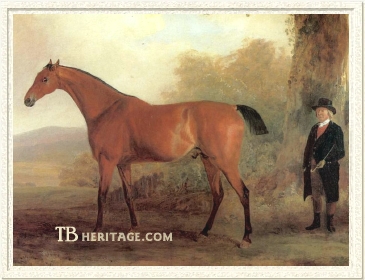 |
|
|
Beningbrough was a great north-country runner, winner of the Doncaster St. Leger and Doncaster Cup on successive days, and an excellent sire of classic winners and good stayers. He got two good sire sons, both of which sired classic winners, and one of these, Orville, got grandsons who were leading sires in England and America. Despite this, this branch of the King Fergus sire line petered out; it was through an undistinguished son of the great King Fergus son Hambletonian that the line continued. Still, some very influential horses descended from Beningbrough via his sons and daughters (four of which produced classic winners), a number of them in-bred to him, and these ensured his name is seen in the pedigrees of many runners today.
Beningbrough was bred by breeder, trainer, and owner John Hutchinson who had a training yard at Malton and a stable and stud at Shipton, the latter located six miles northeast of York. He trained horses for Peregrine Wentworth, Lord Grosvenor, and other important turfites in the latter half of the eighteenth century, and in 1787 purchased the sturdy staying Eclipse son, King Fergus, to use as a stallion at Shipton. Hutchinson bred King Fergus to daughters of such stallions as Herod, Matchem, and Highflyer, and in the 1790s King Fergus offspring from Hutchinson's stud came to dominate north country racing, among them Ormond (from a Matchem mare), Warter (from a Escape's sister, by Highflyer), and Doncaster Cup winners Overton (dam a Herod mare) and Young Traveller (dam by Young Trunnion; he also won the St. Leger). The two most influential sons of King Fergus, both bred by Hutchinson, were the great runner Hambletonian (out of Grey Highflyer), and Beningbrough.
Beningbrough's unnamed dam (1780), by Herod, had been bred by William Fenwick, whose stud was at Bywell in Northumberland. Fenwick is best known as the owner of Matchem, the principal sire line progenitor of the Godolphin Arabian, both when he raced and when he was at stud at Bywell.
Beningbrough's dam was out of Pyrrha (1771), a Matchem daughter, who had also been bred by Fenwick, out of his great running and producing mare, Duchess (1748, by Whitenose). Duchess, who had been bred by Newmarket trainer Thomas Panton and sold to Fenwick as a youngster, was an outstanding race mare, winner of the Great Subscription Purse, both at York and Hambleton, and of numerous King's Plates at Hambleton, Lincoln, Newmarket, and other venues. Her offspring (all bred by Fenwick), in addition to Pyrrha, included Pyrrha's brothers Le Sang, Dux, and Chymist, all very good runners in the 1760s; Le Sang was later a successful sire. Pyrrha produced eleven foals for Fenwick, including Beatrice (1791), whose daughter, Vicissitude, was the dam of the great Family 7 taproot mare, Gibside Fairy. Another Pyrrha daughter, by Young Marske, also bred on: her branch of Family 7 included such horses as classic winners Saltarelle, Luciano, Wild Dayrell, La Sorellina, Caligula, American Flag, Ballymore, and many other great runners.
Beningbrough's dam was unraced, entering the stud at age three, and producing a colt, Ticket, by a moderately successful sire, Orpheus (a son of Le Sang), in 1784, a colt called Tooth-drawer (later called Actaeon and then Sportsman) in 1785, and a filly in 1787, both also by Orpheus. Tooth-drawer was a good runner, placing second to the Prince of Wales' somewhat infamous Escape in York's Great Subscription Purse in 1790. In 1788 she dropped Sandhopper, by King Fergus, and the next year Whitley (1789), her last foal by Orpheus. After that she was bred to King Fergus and his son, Overton. Her seventh foal was Beningbrough.
The red-bay Beningbrough inherited his sire's size, 16 hands, his sturdy constitution and "freedom from blemish," and his good bone size and strength. The Druid described him as "...a horse of very great stamp, and the living image of Herod himself." Combining, as he did, the lines of Eclipse, Herod, and Matchem within the first three generations, and with a strong female line, Beningbrough was "allowed to be one of the finest-bred horses in England." He was described by a groomsman who knew him after he retired to stud as "...anything but a sweet-tempered horse."
Beningbrough on the Turf
Beningbrough ran for four years, and proved to be the best of his generation in the north of England, running exclusively at York and Doncaster. His first race, at age three at the York Spring meeting was a 160 guineas sweep for three year olds, in which he placed second to the Delpini colt, Prior, beating four others. His next outings were at York in August, when he won a three-mile race worth 350 guineas, beating two other colts, and a sweepstakes for fillies and colts, beating a field of six others, including the good race filly Eliza. His next race was the two mile St. Leger at Doncaster in September, beating a field of seven others, including Prior, who ran second. The next day, part of a field of seven, he contested the Doncaster Cup over four miles, winning it easily. His jockey in both Doncaster races was John Jackson, who had his start in Hutchinson's stable, and became one of the most prominent north country jockeys in the last decade of the 18th century.
He did not run again until August of 1795. At the York August meeting Hutchinson sold three of his best runners -- Oberon (by Highflyer), Beningbrough and Hambletonian -- and all their engagements, to Sir Charles Turner, a well-known racing enthusiast whose seat was Kirkleatham Hall, near Redcar. The total amount paid for the three was 3,000 guineas, a very big sum at the time, but the transaction made it into the history books because Turner had phenomenal luck with the purchase. At that meeting Beningbrough only ran third in the Great Subscription Purse, beaten by Brilliant, a Phoenomenon colt. But Hambletonian won two sweepstakes during that meeting. At Doncaster, in September, Beningbrough won a 500 guineas match against Christopher Wilson's Bennington (winner of the Oatlands at Newmarket that year, and second in the Great Subscription Purse at York), the Doncaster Stakes the next day, beating Brilliant and Eliza, and the following day a £100 plate run in two-mile heats, beating Brilliant and three other horses. At that same meeting Hambletonian won the St. Leger and the Doncaster Cup for Turner.
At age five, in 1796, Beningbrough won a four mile match by six lengths against the King Fergus son Ormond, who had been bred by Hutchinson and sold to his client, Peregrine Wentworth; Ormond had won the Great Subscription Purse at York in 1794, and ran second in that race in 1796. A few days later Beningbrough lost a match against Christopher Wilson's Eliza (a great cup and plate-winning four-mile mare who went on to win the Doncaster Stakes that year) over four miles.
Hutchinson re-purchased Beningbrough in 1797, and took him to York in August. There, he received a 50 guineas forfeith in a match against the Pot-8-Os son Yorkshire Bite. He then ran second by two lengths to Hambletonian, the only time they met, in the Great Subscription Purse that had a field of six. The turf gossips of the time say that Hutchinson refused an offer of 3,500 guineas for Beningbrough, but it is not recorded who made the offer. After this season Hutchinson retired Beningbrough to stud.
Beningbrough in the Stud
Beningbrough entered the stud at a fee of 6 guineas. After his son Orville proved to be a good winner, his fee was raised to 25 guineas. He was a popular and successful sire, and for some years it appeared that the King Fergus branch of the Darley Arabian sire line was secure through both Beningbrough's St. Leger-winning son, Orville, who was a leading sire in Great Britain, and his Doncaster Cup-winning son, Scud, who got two Derby winners and an Oaks winner. As it turned out, it was Whitelock, a really modest runner and sire son of Hambletonian, who continued the sire line through his son, Blacklock. Nonetheless, Beningbrough got three classic winners, and four daughters who produced classic winners. Through his sons and daughters, he was a prominent name in English pedigrees through the mid-19th century, and through his daughters had a significant influence in French, American, and Australian bloodstock within twenty years, and he is seen in the extended pedigrees, through both his daughters and sons, of many good runners today . He almost always passed on size and bone to his offspring, and many were, like him, good stayers with a turn of speed.
In 1807 Beningbrough was purchased by a Mr. Dinsdale, and stood at The Grove, near Middleton, until his death on February 7, 1815, at the age of 24. He was buried under a mulberry tree in the garden at The Grove.
|
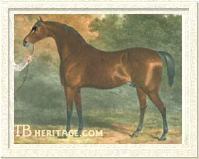
Orville | |
ORVILLE, out of the four-mile race mare Evelina, by the great sire, Highflyer, was an exceptionally stout runner standing over 16 hands, with a powerful, stocky body. He won the St. Leger at Doncaster for his owner and breeder, Lord Fitzwilliam, and later won a number of plates and sweeps at various venues, including Newmarket, for the Prince of Wales. In the stud he got five classic winners and led the sire's lists twice; among his offspring were Derby winner and two-time leading sire Emilius, and the good runner Muley, sire of three classic winners.
|
Muley is best known as the dam's sire of the enormously influential broodmare, Pocahontas and as sire of Muley Moloch, who got Alice Hawthorn, "Queen of the Turf" and dam of Thormanby. Orville's grandsons two-time leading sire Priam and Leviathan, both sent to the U.S., were the dominant sires there in the 1830s and '40s.
Scud
SCUD was Beningbrough's second good sire son. He was bred by W.N.W. Hewett from Eliza (1791), the great four-mile Highflyer mare that on several occasions met and beat Beningbrough on the turf. Sold to Lord Monson, he ran second to the Sir Peter daughter Paulina in the 1807 St. Leger which had a field of 16, including three other Beningbrough sons, HYLAS (ran fourth), PHLEBOTOMIST, and BEDALIAN. The next day SCUD won the Doncaster Cup, beating the good runners Staveley, Thorn, and Sir Andrew. In 1808 he won the Great Produce Stakes at York, with a purse of 1050 guineas.
In the stud of Thomas Thornhill at Riddlesworth, Norfolk, SCUD was "a handsome sire of a handsome race," which included classic winners in three successive years -- Sam (1815), winner of the Derby, Shoveler (1816, out of Hambletonian daughter Goosander), who won the Oaks, and her brother, Sailor (1817), who also won the Derby in the mud in a storm, but dropped dead during exercise on the Newmarket Heath that fall. All three were bred by Thornhill, who also stood the Orville son, Emilius after his racing career was over in 1825. Sam, out of the multiple Gold Cup winner Hyale (a daughter of Phoenomenon), was a half-brother to the Sir Peter son Clinker and Hambletonian's good running son, Anticipation (not to be confused with Beningbrough's daughter Anticipation), the latter also bred by Thornhill. A "low, lengthy and plain sort of horse, with a sour countenance, and a delicate constitution," he was named in honor of the famous jockey Sam Chifney, who rode him in his Derby win. It was soon after this that Thornhill moved all his runners to the stable of Sam and his brother Will, for training, but both Sam and Shoveler lost form after their classic wins. One of Sam's unnamed daughters became tail-female ancestress of Princequillo and other good horses.
|
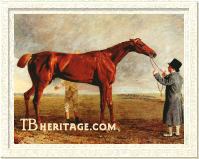 | |  | | Scud's son, the ill-fated Sailor | | Scud's son Sam, with Sam Chifney up |
|
Scud got some other good runners, including Mariner and Sheldrake, out of Goosander, but none of his sons were able to carry the sire line forward. Scud's son, Steeltrap (1815, from Prophetess), bred by Thornhill, was sold to Australia in 1823 and was a famous stallion there; his influence is still felt in Australia and New Zealand through his daughters, seen in the Colonial Families C2, C4, and C16.
|
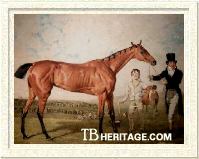
Scud's Oaks winning daughter Shoveler, Sailor's sister | |
Scud's Oaks-winning daughter Shoveler (Family 6 - c), was a "small, lengthy, and blood-like whole-coloured bay mare" who bred on, with a successful branch in Poland and one that produced some classic winners and stayers in Australia. Her sister, Sea-Mew (1815) also bred on, and Sea-Mew's son, St. Nicholas (1827) won some races and got two-time winner of the Goodwood Stakes, Orelia, and two sons, Yorkshire and Nicholas, who were sent to the U.S. where they had some influence in bloodstock breeding.
|
More Beningbrough Offspring
Another son of Beningbrough's was ASHTON (1799), a bay colt bred by Sir William Gerard, whose seat was at Garswood in Lancashire. He was out of the Sir Peter daughter, Mary Ann, who produced a number of other foals to the cover of Beningbrough, all bred by Gerard. Ashton was a good runner; he won the Richmond Gold Cup in 1802, beating Haphazard and some other good horses, and ran second to Walton in a King's Plate held in three mile heats in 1804. Ashton got some good winners, including Effie Deans (1815), whose wins included a race over 2-1/2 miles at Chelmsford, and a match against Philarmonus there; a 200 guineas match against Lepus; the County Members' Plate and the City Members' Plate at Bath; the Gold Cup at Blandford, and a number of other races at various country venues. She retired to the Radclyffe Stud, where she bred some winners, including Windermere and Kate.
In addition to ASHTON, Mary Ann produced ORIANA (1807) to the cover of Beningbrough. ORIANA won the Oaks in her turf debut, beating ten other fillies and went on to place third to Octavian and Recollection in the Doncaster St. Leger. The following year she ran second in the Claret Stakes, and at York August won the Great Subscription Purse, her last race. She was sent to Ireland as a broodmare. Another Beningbrough offspring of out Mary Ann was WINDLE (1804), owned by Lord George Cavendish, who ran at Newmarket and in the stud got some good runners, including several who ran succesfully at Newmarket as three-year-olds, Warwick Town Plate winner Leofric (1815), and the unnamed dam of the aforementioned in-bred Leviathan, who was a successful sire in the U.S. Another sibling was an UNNAMED filly (1811), the dam of the good runner Euxton and of several daughters that bred on: Le Pompom (1891), two-time Prix Jean Prat winner La Grange, South African champion Colorado King (1959) and south African Derby winner Artistry (1975) were among her tail-female descendants.
BRISEIS (1804) was Beningbrough's other Oaks winner, and like ORIANA, she could go a distance, running second to Gustavus in the four mile Nottingham Gold Cup in 1808. She was out of the Sir Peter mare, Lady Jane (1796), whose first foal was the good runner Skirmisher, by Buzzard. In the stud Briseus produced Corinne, by Waxy, who won the One Thousand Guineas and the Oaks, Marcellus (by Selim), winner of the Ascot Gold Cup, and Abjer (by Truffle), who was a moderately successful stallion.
Beningbrough's son TROPHONIUS (1807), raced by Lord Darlington, was out of a mare by Stamford. He won the Doncaster Cup at age three, and beat Whalebone in a 300 guineas sweepstakes at Newmarket at age four. Another good son was THORN (1803), out of Henry Peirse's mare, Constantia, by Walnut; Constantia's last foal was Orville's St. Leger-winning son, Ebor. Peirse sold Thorn to a Mr. Devise; he ran second to SCUD in the Doncaster Cup, and that same year won the Great Produce Stakes at York. He passed through more hands, and in 1810, was owned by a Mr. Andrews for whom he ran second to Meteora in the Stamford Gold Cup. Constantia also produced ALBUERA (1808), a daughter to Beningbrough, who ran unplaced in the 1811 St. Leger and at Newmarket in 1812.
Other Beningbrough sons that were winners were PRINCE OF ORANGE (1811), a chestnut colt out of Hyale, and so half-brother to the aforementioned Scud son, Sam, and the Hambletonian son, Anticipation; BLUE DEVIL (1799), out of a Sir Peter mare; DELVILLE (1803), a brother to ORVILLE, and RUGANTINO (1803), owned by the Prince of Wales, who was a half-brother to Dick Andrews out of a Highflyer mare.
|
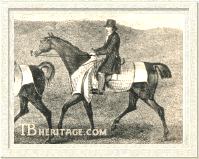
Harefoot
| | Beningbrough's son HAREFOOT (1799) was out of a daughter of Drone, and was half-brother to St. Leger winner Staveley, by Shuttle. Running for his owner J. Wardell, and sold several times during the course of his career, he won the Oatlands at Newmarket Craven meeting, and a several matches at Newmarket, a sweepstakes at Bibury, and was second to Bustard in a King's Plate at Canterbury and to Orville in the Brighton Gold Cup. He was retired to stud at the end of 1805, but left no mark as a stallion. |
| Beningbrough got some good running daughters, and was a successful broodmare sire whose daughters produced classic winners and other good runners. Oaks winner BRISEIS, who bred the dual-classic winner Corinne, has already been mentioned. ROSETTE (1803) produced St. Leger winner Reveller, later a good sire. MISS NANCY (1803) had a St. Leger winner in her good running daughter, The Duchess (1813, by Cardinal York). JOHANNA SOUTHCOTE (1811) produced Oaks winner Variation. |
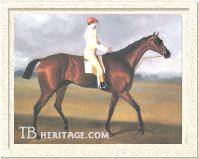
Rosette | | ROSETTE (1803), bred and owned by Henry Peirse, whose stud was near Bedale in Yorkshire, ran for over six years. Her dam was Rosamond, by Tandem, who also produced a UNNAMED sister to Rosette, from whom the Irish stallion Solon (1897), the Prix de l'Arc de Triomphe winner Samos (1932) and other good winners descended in tail-female. Rosette won the Doncaster Prince's Stakes, the Union Cup at Preston, city purses at York, the Richmond Cup, and a number of other races at Catterick and other north country venues.
|
In Peirse's stud she became the dam of St. Leger winner Reveller (1815, by Comus). Her daughter Rosanne (1811, by Dick Andrews) bred on, with a great many stakes winners descending from her in tail-female (Family 19), among them The Seattle Slew son Slewpy (1980), Two Thousand Guineas winners Privy Councillor (1959) and Roland Gardens (1975), German Derby winner and sires Surumu (1974) and Marduk, and St. Leger winner Scottish Union (1935).
Beningbrough's daughter MISS NANCY (1803) was out of a mare by Ruler, bred by Mr. Ellerker. Her daughter, the excellent staying mare The Duchess (1813, by Cardinal York) won the Pontefract Gold Cup, twice, the Doncaster St. Leger, the Doncaster Stakes, the Richmond Cup, the York Cup at York Spring meeting; the Club Stakes at Doncaster, York's Great Subscription Purse, the Gosforth Stakes and the Cup at Newcastle. In the stud Duchess became second dam of Chester Cup winner King Cole (1833, by Memnon).
JOHANNA SOUTHCOTE (1811), bred by a Mr. Hallett, produced Oaks winner Variation (1827, by Bustard), and another daughter, Young Johanna Southcote (1826, by Walton) produced a good runner, the Physician son, Doctor (1840). Variation produced the good runner Pompey (1840, by Emilius), and other in-bred "E" (Emilius daughters bred by Thornhill) sisters to Pompey that bred on, including Evasion (1839), whose tail-female descendants included Australian cracks Navigator (1879) and Trident (1883); and Elphine (1837), dam of St. Leger winner Warlock (1853) and some good runners by The Cure, and tail-female ancestress of a host of good Irish horses, including Kircubbin (1818), Ki Ming (1948, Two Thousand Guineas), and Doncaster Cup winner Wavelet's Pride (1897), and the great Carvin filly Pawneese (1973), winner of both the Oaks and the Prix de Diane.
Other Beningbrough daughters who were influential within a couple of generations included: AZALIA (1804), from Gilliflower by Highflyer, whose son, The Flyer (1814), was the sire of Oaks and Epsom Gold Cup winner Wings (1822), later dam of Ascot Gold Cup winner Caravan, and French One Thousand Guineas winner Fiammetta; ORVELLINA (1804), the sister of Orville, whose son, Sandbeck, won the Club Stakes at Doncaster and the Fitzwilliam Stakes at York, and in the stud got Barbelle, the dam of the great juvenile runner and Gold Cup winner, Van Tromp, and his half-brother, the dual-classic winner and Yorkshire legend, The Flying Dutchman, who had such a significant influence on French breeding through his son Dollar; LADY MARY (1800), out of a Highflyer mare, whose daughter by Smolensko (1818) produced Royal Oak (1823, by Catton), France's leading sire in the 1830s with three French Derby and four French Oaks winning sons and daughters and son Slane (1833), who became a leading sire in England.
SPITFIRE (1800), listed in the GSB as out of a Young Sir Peter mare with a caveat questioning her breeding, was the dam of the Dick Andrews daughter Nancy (1813), who produced the good runners Longwaist, Staightwaist, and Muley Moloch, winner of Doncaster's Champagne Stakes and sire of "Queen of the Turf" Alice Hawthorn, who was in-bred to Beningbrough. A daughter of Nancy's, Muliana, bred on, and it is through her tail-female line (Family 9 - c) that Americus Girl (1905) emerged, the dam, second dam and ancestress of such horses as Lady Josephine, Lady Juror, Mumtaz Mahal, Mahmoud, Petite Etoile, Migoli, Abernant, Fair Trial, Tudor Minstrel, and Nasrullah.
An UNNAMED Beningbrough daughter was bred by Humphrey Osbaldeston of Hunmanby out of his Carbuncle mare, Jenny Mole. In the stud she produced Dr. Syntax, an exceptionally sturdy runner and winner of the Richmond Cup five times, and the Gold Cup at Preston seven times, and Miss Syntax, the dam of the good runner Scipio (1825) and the good running Tramp son, Little Red Rover (1827). Beningbrough's daughter also produced Oceana (1816, by Cerberus), who bred on: the good American runners Purchase (1916, by Ormondale) and Knight of Ellerslie (1881, by Eolus) descended from her. Dr. Syntax was the sire of the celebrated race mare Beeswing, who was later dam of Two Thousand Guineas winner Nunnykirk (1846) and St. Leger winner Newminster (1848), a two-time leading sire. Beeswing's daughters were tail-female ancestresses of many stakes winners in Family 8.
Beningbrough's daughter ANTICIPATION (1802), out of Expectation, by Herod, produced a number of daughters that bred on. One, Handmaiden (1817, by Walton, Family 4 - b) bred Inheritor, a Cup winner and useful sire, and Executrix, fourth dam of Vanessa (1861, by Newminster and so in-bred to Beningbrough), who established a strong female family in Germany, loaded with German classic winners including the influential sire Herold (1917), and this branch of the family also made a mark in South America, with El Asesor (1980) and others. Another Anticipation daughter, by Cervantes (1818), was the dam of Rebecca (1831, by Lottery) who produced The Provost and Annadale, both good runners, and the great race mare Alice Hawthorn (in-bred to Beningbrough through Muley Moloch), head of Family 4 - f. Yet another Anticipation daughter, Maniac (1806, by Shuttle), produced Doncaster Cup winner Fulford, and through daughters heads the Family 4 - c branch, which includes Man o' War (1917); Assault (1943); the host of good runners, including four classic winners descending tail-female from Weighbridge (1945); Scottish Chief daughter Thistle (1975), dam of English Triple Crown winner Common, his half-brother Goldfinch, and half-sister St. Leger winner Throstle; and a host of other outstanding horses in countries throughout the world.
A great many other Beningbrough daughters bred on, producing solid runners, often stayers, and can be seen in the far reaches of bloodstock pedigrees throughout the world today.
--Patricia Erigero
|
|
|
|

